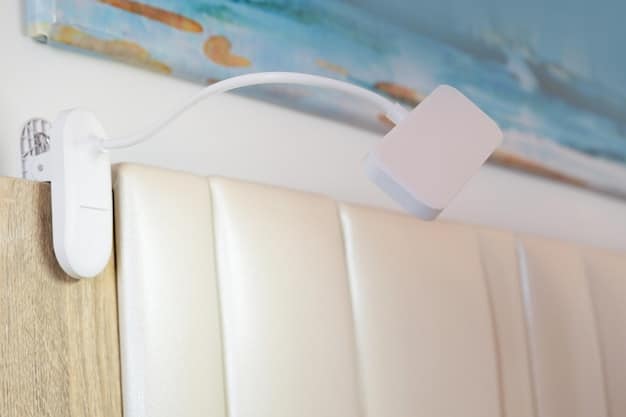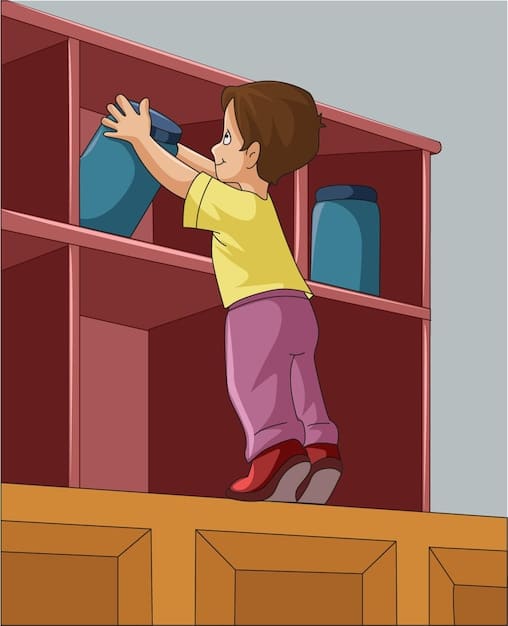Budget-Friendly Babyproofing: Top 10 Safety Measures Under $100

Babyproofing on a Budget: 10 Essential Safety Measures for Under $100 outlines practical and affordable strategies to ensure a safe environment for your little one without breaking the bank, covering everything from outlet covers to furniture anchoring solutions.
Bringing a new baby into your home is an exciting time, but it also comes with the serious responsibility of ensuring their safety. While professional babyproofing services can be expensive, it’s entirely possible to create a safe environment without spending a fortune. This guide, Babyproofing on a Budget: 10 Essential Safety Measures for Under $100, provides practical advice and cost-effective solutions to help you protect your little one.
Why Babyproofing is Essential, Even on a Budget
Babyproofing isn’t just a suggestion; it’s a necessity. Babies and toddlers are naturally curious and explore their surroundings by touching, grabbing, and tasting everything they can reach. This inherent curiosity, while vital for development, can expose them to numerous hazards within the home.
Even on a tight budget, neglecting babyproofing can lead to serious injuries, from minor bumps and bruises to more severe accidents like falls, burns, or poisoning. The relatively small investment in safety measures can save you from costly medical bills and, more importantly, protect your child from harm.
Understanding the Risks
Before diving into specific safety measures, it’s crucial to understand the common hazards lurking in your home that can post a risk to children. Electrical outlets, sharp corners, unsecured furniture, and access to stairs and cleaning supplies are just some of the high-risk areas.
Focusing on Key Areas
Start by identifying the areas your baby will be spending the most time, such as the living room, kitchen, and bedrooms. Prioritize these areas when implementing your babyproofing strategy. Remember babyproofing is more than just buying products. It’s about using your observation skills to see the world through the babies eyes.

In conclusion, babyproofing is an investment that doesn’t need to be expensive. By understanding the risks and prioritizing key areas, you can create a safe environment for your child without breaking the bank. It’s about being proactive and making informed choices to protect your little one’s well-being.
1. Outlet Covers: A Simple and Effective Solution
Electrical outlets are a significant hazard for babies and toddlers. Their small fingers can easily fit into the openings, leading to electrical shock. Thankfully, outlet covers are an inexpensive and readily available solution.
Outlet covers are designed to block access to the electrical sockets, preventing children from inserting anything into them. They come in various types, including simple plastic inserts and more sophisticated self-closing covers. Choose the ones that best suit your needs and budget.
- Basic Plastic Inserts: These are the most affordable option and simply plug into the outlet holes.
- Self-Closing Outlet Covers: These covers automatically close when an appliance is unplugged, providing continuous protection.
- Outlet Boxes: These are installed over the existing outlet and provide a barrier to prevent access.
When selecting outlet covers, ensure they are made from durable, non-toxic materials and are difficult for children to remove. Regularly check the covers to make sure they are still securely in place. Be sure to have enough to cover all outlets in your home.
2. Cabinet and Drawer Locks: Keeping Dangerous Items Out of Reach
Cabinets and drawers often contain cleaning supplies, medications, and sharp objects that can be harmful to curious children. Installing cabinet and drawer locks is a simple and effective way to prevent access to these dangerous items.
There are many different types of cabinet and drawer locks available, ranging from magnetic locks to adhesive latches. Choose the ones that are appropriate for your cabinets and drawers and that are difficult for children to open.
Types of Locks
- Magnetic Locks: These locks attach inside the cabinet or drawer and require a magnetic key to open.
- Adhesive Latches: These latches stick to the cabinet or drawer and can be easily opened by adults but not by children.
- Spring-Loaded Latches: These latches require a squeeze to open, making them difficult for small children.
When installing cabinet and drawer locks, make sure to follow the instructions carefully and test the locks to ensure they are working properly. Regularly check the locks to make sure they are still securely attached. Pay special attention to the locks in the kitchen and bathroom where cleaning and other dangerous items are stored.
3. Furniture Anchors: Preventing Tip-Over Accidents
Furniture tip-overs can cause serious injuries, especially to young children. Tall bookcases, dressers, and televisions are particularly prone to tipping over if climbed on or pulled. Anchoring furniture to the wall is an essential safety measure that can prevent these accidents.
Furniture anchors are inexpensive and easy to install. They typically consist of straps or brackets that attach to the furniture and the wall, preventing the furniture from tipping over.
Installation Tips
- Use Stud Finders: Secure the anchors to wall studs for maximum stability.
- Check Weight Limits: Ensure the anchors are rated to support the weight of the furniture.
- Conceal Straps: Hide the straps behind the furniture to make them less visible.

When anchoring furniture, make sure to follow the manufacturer’s instructions carefully and test the anchors to ensure they are securely attached. Regularly check the anchors to make sure they are still tight and that the furniture is stable. Do not place tempting toys or other things on top to prevent the child from attempting to climb them.
4. Corner and Edge Guards: Softening Sharp Surfaces
Sharp corners and edges on tables, countertops, and other furniture can pose a significant risk of injury to toddlers learning to walk. Corner and edge guards are designed to soften these surfaces, reducing the risk of bumps, cuts, and bruises.
These guards are typically made from soft, impact-absorbing materials like foam or rubber. They attach to the corners and edges of furniture using adhesive, providing a cushion against accidental impacts.
When selecting corner and edge guards, choose ones that are made from non-toxic materials and are easy to clean. Regularly check the guards to make sure they are still securely attached and replace them if they become damaged or loose.
5. Window Cord Safety: Eliminating Strangulation Hazards
Window cords can be a strangulation hazard for young children. Loose or dangling cords can easily become entangled around a child’s neck, leading to serious injury or even death. Taking steps to eliminate this hazard is crucial for babyproofing your home.
There are several ways to address window cord safety. Shortening the cords, using cord cleats to keep them out of reach, or replacing window coverings with cordless options are all effective measures. Cordless blinds and shades and those without accessible cords are available in stores and online.
6. Baby Gates: Restricting Access to Dangerous Areas
Stairs are a common source of falls for young children. Installing baby gates at the top and bottom of stairs can prevent access to these dangerous areas. Baby gates can also be used to block off other areas of the home that may be unsafe, such as the kitchen or laundry room.
There are two main types of baby gates: pressure-mounted gates and hardware-mounted gates. Pressure-mounted gates are easy to install and remove, but they may not be as secure as hardware-mounted gates. Hardware-mounted gates are more secure but require drilling into the wall or door frame.
7. Non-Slip Bath Mats: Preventing Slips and Falls in the Bathroom
The bathroom can be a slippery place, especially when wet. Non-slip bath mats can provide traction and prevent slips and falls in the bathtub or shower. Choose bath mats that are made from non-slip materials and that are easy to clean.
Regularly clean the bath mats to prevent mildew and bacteria growth. Avoid using bath mats with small suction cups, as these can pose a choking hazard.
| Key Point | Brief Description |
|---|---|
| 🔌 Outlet Covers | Prevent electrical shocks by covering exposed outlets. |
| 🔒 Cabinet Locks | Secure cabinets and drawers to keep dangerous items out of reach. |
| 🧱 Furniture Anchors | Anchor tall furniture to the walls to prevent tip-over accidents. |
| 🛁 Non-Slip Mats | Use in bathrooms to reduce risk a slip and fall |
Frequently Asked Questions About Budget Babyproofing
▼
Yes, babyproofing is crucial for creating a safe environment for your child. Babies and toddlers are naturally curious and explore their surroundings by touching, grabbing, and tasting everything they can reach. This exploration can expose them to various hazards, making babyproofing a necessity to prevent injuries and accidents.
▼
Ideally, you should start babyproofing before your baby becomes mobile. Crawling typically begins around 6-10 months, so aim to have your home babyproofed by then. However, it’s never too late to start, and you can continue to update your babyproofing measures as your child grows and develops.
▼
The most important areas to babyproof are those where your baby will be spending the most time. This includes the living room, kitchen, bedrooms, and bathrooms. Pay extra attention to areas with potential hazards, such as stairs, electrical outlets, and cabinets containing cleaning supplies.
▼
Absolutely! This guide focuses on essential babyproofing measures that can be implemented for under $100. Many affordable solutions are available, such as outlet covers, cabinet locks, and furniture anchors. By prioritizing key areas and choosing budget-friendly options, you can create a safe environment without breaking the bank.
▼
Affordable babyproofing products can be found at many retailers, including dollar stores, discount stores, and online retailers such as Amazon. Additionally, check for sales and discounts on babyproofing products at your local baby stores or supermarkets.
Conclusion
Babyproofing on a budget is not only possible but also a crucial step in ensuring your child’s safety and well-being. By implementing these ten essential safety measures, you can create a secure and nurturing environment for your little one to explore and grow. Remember, small changes can make a big difference in protecting your child from potential hazards within your home.





